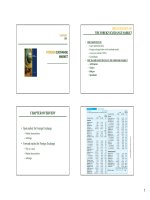Lecture Jazz (Tenth edition) Chapter 6 Swing
Bạn đang xem bản rút gọn của tài liệu. Xem và tải ngay bản đầy đủ của tài liệu tại đây (202.89 KB, 39 trang )
Jazz
Tenth Edition
Chapter 6
PowerPoint
by
Sharon Ann Toman, 2004
© 2005 The McGraw-Hill Companies, Inc. All rights reserved.
Beginning of the Swing Era
2
Name given to the era that follows the
boogie-woogie
In general, refers to the music of large-dance
bands that played written arrangements
Chapter 6 - Swing
© 2005 The McGraw-Hill Companies, Inc. All rights reserved.
Beginning of the Swing Era
Swing did not “swing” but rather…
Involved jazz performers doing a jazz interpretation of
pretty ballads
3
Ballad: is a simple song, usually romantic in nature and
uses the same melody for each stanza
Chapter 6 - Swing
© 2005 The McGraw-Hill Companies, Inc. All rights reserved.
Beginning of the Swing Era
4
Some listeners feel that all Swing bands
sound alike…but band leaders wanted to be
distinguished …like:
Tommy Dorsey: played with a beautiful tone and
control on the trombone
Glenn Miller: used a clarinet over his saxophone for
identification
Chapter 6 - Swing
© 2005 The McGraw-Hill Companies, Inc. All rights reserved.
Beginning of the Swing Era
Swing bands adopted a consistent instrumentation
that remained fairly stable – four sections each:
1.
2.
3.
4.
5
Saxophone section-two alto saxophones, two tenor
saxophones, and one baritone saxophone
Trumpet section-four trumpets; the first was responsible
for the highest notes and eventually the second player for
most of the jazz solos
Trombone section-four trombones; later a fifth bass
trombone was often added
Rhythm section-one drummer, one bass player (string
bass), one piano player, and one guitar player
Chapter 6 - Swing
© 2005 The McGraw-Hill Companies, Inc. All rights reserved.
Jazz Arrangements
The general procedure in the creation of a
swing jazz arrangement was:
6
Write a score that has specific notes for each
instrument to play in every measure
Indicate measures for solo improvisation
Musical notations with the desired sounds
Short, repeated refrains or phrases, or riffs,
are common in jazz
Chapter 6 - Swing
© 2005 The McGraw-Hill Companies, Inc. All rights reserved.
Fletcher Henderson (1897-1952)
Credited with creating the pattern for swing
arrangements which consists of:
7
Independent use of trumpet, trombone, saxophone, and
rhythm section, with use of soloist
A pianist and excellent arranger
Wrote most of the musical arrangements that
helped launch the success of Benny
Goodman’s orchestra
Chapter 6 - Swing
© 2005 The McGraw-Hill Companies, Inc. All rights reserved.
Fletcher Henderson (1897-1952)
Henderson’s arrangements used:
8
1. tighter harmonic control
2. less emphasis on improvisation
3. control use of polyphony
Chapter 6 - Swing
© 2005 The McGraw-Hill Companies, Inc. All rights reserved.
New York
New York was an important geographic area
for the developments leading toward the
swing style of jazz and important names
like:
9
Chick Webb
Jimmie Lunceford
Duke Ellington
Chapter 6 - Swing
© 2005 The McGraw-Hill Companies, Inc. All rights reserved.
Chick Webb (1909-1939)
Admired drummer for his forceful sense of:
Swing
Accurate technique
Control of dynamics
Breaks and fills
Couldn’t read music….but memorize the arrangements
Would conduct his band from his drum set
Ella Fitzgerald contributed to Webb’s bands success in NYC
10 Chapter 6 - Swing
© 2005 The McGraw-Hill Companies, Inc. All rights reserved.
Jimmie Lunceford (1902-1947)
Alto sax player/band arranger
Graduated from Fisk University (BMus1926)
Taught music at Manassas High School, Memphis –
in 1927 organized a student jazz band and released
its first recording in 1930
This band emphasized correct technique and
accurate playing
11 Chapter 6 - Swing
© 2005 The McGraw-Hill Companies, Inc. All rights reserved.
Duke Ellington (1899-1974)
Proved that orchestrating jazz was an art of the
highest level
His music was a combination of solo and ensemble playing
The Ellington orchestra was always made up of the
individual talents of his players
This is one of important aspects of the Ellington band which
allowed individuals to retain their own identities and to
expand and explore their own directions
12 Chapter 6 - Swing
© 2005 The McGraw-Hill Companies, Inc. All rights reserved.
Kansas City
Kansas City was busy with musical activity from the
early 1920s to about 1938
Political organization called:
Pendergast Machine
Encouraged nightclub atmosphere
Employment and opportunities for jazz musician arose
Kansas City became a jazz mecca
13 Chapter 6 - Swing
© 2005 The McGraw-Hill Companies, Inc. All rights reserved.
Mary Lou Williams (1910-1981)
1st woman in jazz history to compose and arrange for
a large jazz band
Considered one of the great jazz pianists
One of the greatest performers from Kansas City
Arranged music for dozens of leading swing bands
like:
Duke Ellington
Dizzy Gillespie
Benny Goodman
14 Chapter 6 - Swing
© 2005 The McGraw-Hill Companies, Inc. All rights reserved.
Count Basie (1904-1984)
Outstanding represents the big band style
Pianist, accompanist, and music director for blues singers,
dancers, and comedians
Band leader/arranger
Traveled throughout Europe and Japan during the 1950s and
1960s
Count Basie’s music contains:
Moving rhythms
Economic piano style (less is better than more)
Relaxed swing sound
15 Chapter 6 - Swing
© 2005 The McGraw-Hill Companies, Inc. All rights reserved.
Southwest Bands – Early Basie
Southwest bands offered a different solution
to big-band improvisational structures
Recognized individual arrangers
Players contributed themselves
Looser compositional structure
Focus shifted away from the arranger and toward the
improvising performer
16 Chapter 6 - Swing
© 2005 The McGraw-Hill Companies, Inc. All rights reserved.
Swing Becomes Accepted…
The depression(1929) found the music business
suddenly failing
Only hotel-type bands (Guy Lombardo) and better
jazz players (Benny Goodman) survived
Swing was really established around 1929 with its
1st recording - “Casa Loma Stomp” in 1930
17 Chapter 6 - Swing
© 2005 The McGraw-Hill Companies, Inc. All rights reserved.
Swing Becomes Accepted…
Upsurge in dancing
Repeal of the Volstead Act in 1933
This law prohibited the manufacture,
transportation and sale of beverages
Social life changed and large ballrooms were
needed for the thousands who wanted to
dance every night and large bands seemed
to be the answer to the dance halls
18 Chapter 6 - Swing
© 2005 The McGraw-Hill Companies, Inc. All rights reserved.
Swing Becomes Accepted…
Swing bands produced a fuller sound than
that of the Dixieland bands
Swing bands used 2 or 3 times as many
players compared to Dixieland bands
Swing band’s music was more organized in
homophony – creating sounds more
organized
19 Chapter 6 - Swing
© 2005 The McGraw-Hill Companies, Inc. All rights reserved.
Swing Becomes Accepted…
Swing bands returned to the use of a flatfour rhythm
Swing bands used block chords
(chords with many notes moving in parallel motion)
20 Chapter 6 - Swing
© 2005 The McGraw-Hill Companies, Inc. All rights reserved.
Paul Whiteman (1890-1967)
Called “King of Jazz” because:
He sought after talented top names for his band
like:
Bing Crosby, Bix Beiderbecke, Jimmy and Tommy
Dorsey, and others
His 1st band was started in San
Francisco(1918)
His fame spread into the 1920s
21 Chapter 6 - Swing
© 2005 The McGraw-Hill Companies, Inc. All rights reserved.
Paul Whiteman (1890-1967)
“The King of Jazz” was the 1st film in
technicolor (1st musical/film had no story,
1930)
Increased the size of his band into nearly
symphonic proportion
His popularity never ceased
22 Chapter 6 - Swing
© 2005 The McGraw-Hill Companies, Inc. All rights reserved.
The Swing Bands
By the late 1930s, prosperity was returning, and
records and radio were extremely helpful in
publicizing jazz
The 1st jazz concert took place in 1936 in NYC – it
was called a “Swing Music Concert”
Benny Goodman jazz concerts were presented for
the 1st time at Carnegie Hall in NYC (1938)
23 Chapter 6 - Swing
© 2005 The McGraw-Hill Companies, Inc. All rights reserved.
The Swing Bands
Dorsey Bros. started with a large-band
version of Dixieland with singer Bob Crosby
Crosby developed his own band…
Later…the public decided that the most
popular of all swing bands was Glenn Miller
24 Chapter 6 - Swing
© 2005 The McGraw-Hill Companies, Inc. All rights reserved.
Glenn Miller (1904-1944)
Brilliant arranger
Outstanding businessman
Fine trombone player
Went in debt to start his band…but within 2 years was a
millionaire
Band works the best jobs and recorded often
Had a radio program
Made motion pictures
25 Chapter 6 - Swing
© 2005 The McGraw-Hill Companies, Inc. All rights reserved.









